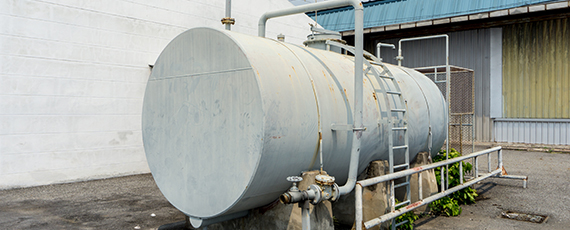Bulk Oil Storage Tank Guidelines
Risk management advice relating to petroleum storage.

Accidents related to bulk petroleum tanks can be expensive, time-consuming, and environmentally damaging. These types of accidents can be a major concern for our dealership clients.
This risk management bulletin provides valuable information and guidance to help you reduce the chance of claims or losses related to oil storage tanks including:
- Soil and water contamination.
- Cleanup costs.
- Theft and vandalism.
- Adverse environmental audit.
Advantages of Aboveground Tanks vs. Below Ground Tanks
- Leaks are easily detectible and quick to contain.
- Facilitates routine visual inspection.
- Can be safely relocated to a different part of the property as circumstances change.
- Can be removed if circumstances change.
Type of Tank
- All tanks should have an Underwriters Laboratory of Canada (ULC) outdoor-use designation and should be stamped as such on the information tag.
- Tanks designed for flammable liquids such as gasoline should be fire-guarded or vaulted to prevent fuel ignition for two hours during a fire.
- A secondary containment area should be in place and have the capacity to hold the contents of the primary tank.
- This requirement is satisfied if the tank is of double-wall* construction.
- If the tank is not of double-wall construction, then the requirement is satisfied if the tank is situated inside a dike.
*Double-walled tanks are preferred as snow, ice, and rainwater can collect in the dike and cause further problems.
Selecting Tank Sites
- The tank should be located a minimum of 50 feet away from buildings, creeks, roads, wells, power lines, and property lines.
- The tank should not be placed where sources of ignition are present such as where cutting and welding torches are used.
- The tank should be installed on flat ground so that spill or leak will not run downhill towards creeks, ditches, drains, etc.
Tank Installation
- Tanks should be placed on a reinforced concrete pad at least six inches thick (large tanks may require stronger support).
- Tanks should be at least six inches off the ground to reduce corrosion, allow for inspection, and permit painting of the underside.
- Tanks should rest on steel supports manufactured for their weight and maximum contents.
General
- The tank should be properly labelled to identify its contents, tank volume, hazards, and warnings to ensure that emergency responders can easily determine what products they are dealing with when responding to an emergency.
- To allow for expansion, tanks should not be filled to more than 95% of its maximum capacity.
- In order to prevent vehicular contact, barriers should be installed. The most commonly installed barrier are pipe bollards, normally 4” - 6” in diameter, spaced approximately 3’ apart, and placed at least 3’ from the tank.
- Tanks storing flammable liquids should be grounded.
- All electrical elements should be explosion-proof, and all wiring should be fuel resistant.
- The emergency shut-off should be located at least 15’ from the tank, but no more than 120’.
- The tank should be equipped with both a primary and emergency vent.
- A spill kit should be in place within close proximity of the tank.
- Nozzles, outside pumps, switches, and the fill portal should be locked and indoor switches should be turned-off when not in use.
- An ABC fire extinguisher (using monoammonium phosphate) should be placed within close proximity of the tank.
Conclusion
Oil storage tank safety begins with making informed decisions about the type of tank you purchase and how it is installed. From there, being proactive about safety practices and maintenance can help minimize the risk your storage tank represents.
For more information on loss control, please contact your Marsh Advisory representative:
Sathyan (Sath) Laloo
416 200 0943 | Fax: 416 349 4564
sathyan.laloo@marsh.com
This document and any recommendations, analysis, or advice provided by Marsh (collectively, the “Marsh Analysis”) are not intended to be taken as advice regarding any individual situation and should not be relied upon as such. This document contains proprietary, confidential information of Marsh and may not be shared with any third party, including other insurance producers, without Marsh’s prior written consent. Any statements concerning actuarial, tax, accounting, or legal matters are based solely on our experience as insurance brokers and risk consultants and are not to be relied upon as actuarial, accounting, tax, or legal advice, for which you should consult your own professional advisors. Any modelling, analytics, or projections are subject to inherent uncertainty, and the Marsh Analysis could be materially affected if any underlying assumptions, conditions, information, or factors are inaccurate or incomplete or should change. The information contained herein is based on sources we believe reliable, but we make no representation or warranty as to its accuracy. Except as may be set forth in an agreement between you and Marsh, Marsh shall have no obligation to update the Marsh Analysis and shall have no liability to you or any other party with regard to the Marsh Analysis or to any services provided by a third party to you or Marsh. Marsh makes no representation or warranty concerning the application of policy wordings or the financial condition or solvency of insurers or re-insurers. Marsh makes no assurances regarding the availability, cost, or terms of insurance coverage.
